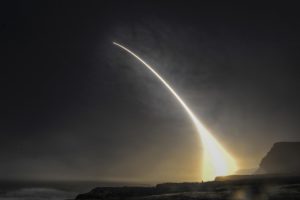Cost estimates of the plan to replace the U.S nuclear stockpile continue to increase on several fronts. The latest Arms Control Today reports that the cost of the replacement for the Minuteman III (MMIII) missile, called the ground-based strategic deterrent (GBSD), may rise to $100 billion or more.
The article cites an “informed source” who says that this brings the total cost to acquire, operate, and sustain the system over its expected 50-year life span to $238 billion.
The latest bad news for the GBSD follows a story from early September that reported a potential increase to $85 billion, a jump of 36 percent from the current estimate. Such sharp increases are raising new questions about the viability of the program and the overall budget for modernizing U.S. nuclear weapons.
With all three legs of the triad—land-based missiles, bombers, and submarines—being considered for modernization, there is concern about an approaching “bow wave” of spending on nuclear programs in the 2020s that could submerge the U.S. defense budget.
Out With the Old…

An unarmed Minuteman III missile launches in an operational test from Vandenberg Air Force Base, CA. Image: Michael Peterson, U.S. Air Force
The Minuteman III, which became operational in 1970, is expected to remain operational until at least 2030. The United States currently deploys 440 of these missiles in silos on three Air Force bases scattered across five states: Montana, North Dakota, Wyoming, Nebraska and Colorado. That is down from 450 missiles deployed previously, and under the New START arms control agreement with Russia that number will be reduced to 400 deployed missiles by 2018.
Note, however, that the 50 missiles removed from deployment will not be destroyed but kept in reserve, and all 450 silos will be maintained.
A 2014 RAND study of future options for the Minuteman III concluded that incremental modernization of the existing missile would be a cost-effective alternative and should be considered. Specifically, RAND calculated at the time that incrementally modernizing the MMIII would cost $60 to $90 billion, while a new silo-based ICBM would require between $84 billion and $125 billion over a 39-year life cycle.
One potential complication with indefinitely extending the life of the existing MMIII is that the United States will eventually run out of missiles to use for testing. The time when this would happen could be extended by reducing the number of destructive tests, reducing the number of deployed missiles, or both. Moreover, given that there are questions about the long-term need to maintain these missiles at all (see discussion below), eventual depletion of the missile inventory may not be a good reason to undertake the expense of a new missile.
And In With the New
Despite these questions, however, the Air Force decided to go ahead with planning to develop and deploy a new ICBM, which it estimated in 2015 would cost $62 billion over 30 years. The GBSD is scheduled to begin deployment by 2029 and last until 2075. It will use the existing MMIII silos and launch control facilities, but will have a new missile, as well as a new command and control system. The plan is to build 666 of these new missiles (400 will be deployed) and the modernized command and control structure to go with them.
A report in early September cited a new analysis by the Pentagon’s Cost Assessment and Program Evaluation (CAPE) office, which provides independent assessments of DOD programs. The report concluded that the GBSD would instead require $85 billion: $22.6 billion for research and development, $61.5 billion for procurement, and $718 million for military construction. This is in line with the previously noted RAND estimate for a similar program.
The report also mentioned a memo from Frank Kendall, the Pentagon’s top acquisition official, which noted that, given the high level of uncertainty involved with the program, the $85 billion estimate is still assumed to be on the low end of potential costs. According to the memo, a revised final cost estimate for the program is expected in 2018, when the service has a more detailed design for the missile and a better grasp of overall costs. The more recent reporting on the program indicates Kendall’s memo did not include the higher-end $100 billion figure from the original CAPE report. The CAPE report was prepared in support of a “milestone AAA” decision about whether to proceed with acquisition of the system, which Kendall approved on August 23.
Although earlier in the process of investigating alternatives there was talk of moving to a mobile basing system for the GBSD, the Air Force narrowed its focus to systems that would use existing silos. The RAND study estimated that a mobile-based missile would cost roughly twice as much as continuing to modernize the existing MMIII. But even though the current GBSD plan abandons the idea of mobile basing, it is not clear whether the Air Force has completely ruled out the possibility of moving to an alternative basing mode at some point. In an email from March of this year, an Air Force spokesperson said that the selected GBSD design “will provide the option for alternative modes of operation in the future.”
The Bigger Picture
In addition to the follow-on ICBM, the United States plans to replace its existing Ohio-class ballistic missile submarines and is developing a new bomber. Taken together, the cost of modernizing all three legs of the triad has been estimated at $1 trillion over the next three decades, with a large chunk of that spending coming due in the 2020s.
Given that it is U.S. policy to reduce reliance on nuclear weapons over time, the Union of Concerned Scientists and others have questioned whether all of these programs are needed. In particular, we have advocated for cancelling the proposed new nuclear-armed cruise missile, which would save $20-30 billion.
However, to significantly reduce its nuclear weapons budget in the long run, the United States would most likely have to eliminate one or more legs of the triad. The most vulnerable leg both politically and literally—in terms of its ability to withstand a Russian nuclear attack—is the land-based ICBMs. The original rationale for these missiles during the Cold War was as insurance against a first strike from Moscow. The “Minuteman” is named for its ability to launch quickly—within minutes—before the missiles could be wiped out by incoming warheads. Even if they were not launched before an attack landed, however, the missiles could still act as a “warhead sink”—if the Soviet Union/Russia wanted to take out the MMIII missiles in their widely spaced and deeply buried silos, it would have to expend a large portion of its nuclear arsenal to do so.
Now that the likelihood of a massive surprise attack is very low, and submarine-launched ballistic missiles provide a formidable deterrent force that is secure against a first strike, a number of analysts have questioned the logic behind retaining the ICBMs, much less spending billions to upgrade them. Former Defense Secretary William Perry has argued for eliminating the land-based leg of the triad, calling it “destabilizing,” and saying that ICBMs are not needed in “any reasonable definition of deterrence.”
Perry and others also argue that ICBMs are riskier than the other legs of the triad, precisely because of their ability to launch in minutes. This short time frame, combined with the decision in the most recent U.S. Nuclear Posture Review to retain options in the warplan to launch on warning, before an incoming attack can land, means that ICBMs are more vulnerable than other legs of the triad to being launched based on mistaken information. And, once launched, they cannot be recalled.
But even if the US decided to retain some ICBMs for the time being, there is nothing magical about having 400 of them. That assumes a constant number of deployed ICBMs from 2018 to 2029. Since the US submarine force provides a strong and secure deterrent, and the Pentagon sees “no viable near or mid-term threats to the survivability of U.S. SSBNs,” a much smaller number of refurbished MMIIIs would be enough to serve—along with the bomber fleet—as a hedge as the US addressed any long-term concerns about submarine vulnerability. This would greatly cut costs and provide plenty of missiles for continued testing.
Where to Cut?
The cost of nuclear modernization programs, together with plans for additional major spending on conventional weapons and a tight defense budget, means that difficult choices will need to be made, and soon. Given significant increases in the estimates for replacing the MMIII and existing skepticism over the long-term requirement for ICBMs, the GBSD may be one program that faces some serious questions.
